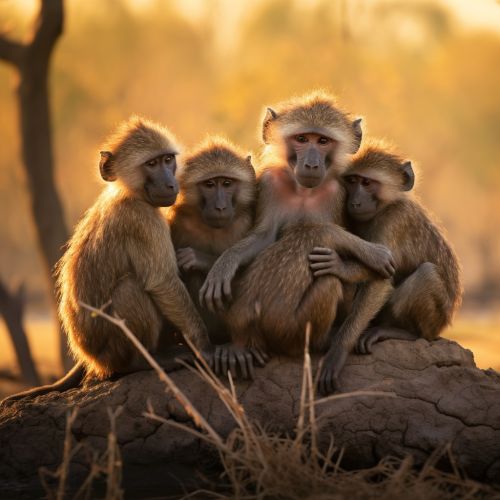This title does not comply with Wikipedias title policy. Suggested title: Baboon Behavior and Reproduction
Behavior
Baboons are some of the world's largest monkeys, and are known for their complex and diverse social behaviors. They live in groups, known as troops, which can consist of dozens to hundreds of individuals, depending on the species and environmental conditions. These troops are multi-male, multi-female groups, with a strict dominance hierarchy that determines access to resources and mates.


Baboons communicate using a variety of vocalizations, body postures, and facial expressions. Vocalizations can range from grunts and barks to screams and roars, each with its own specific meaning. Body postures and facial expressions are also used to convey information about status, mood, and intentions. For example, a baboon may bare its teeth to signal aggression, or present its rear end to signal submission.
Baboons are diurnal, meaning they are active during the day and sleep at night. They spend the majority of their day foraging for food, which can include fruits, grasses, seeds, roots, and occasionally small animals. They are also known to raid human crops and livestock, which can lead to conflicts with local communities.
Reproduction
Baboon reproduction is characterized by a polygynandrous mating system, where both males and females have multiple mates. The mating season is not strictly defined and can occur throughout the year, although it may peak during times of food abundance.
Females signal their readiness to mate by exhibiting sexual swellings, which are changes in the size, shape, and color of the skin around their genital area. These swellings reach their maximum size when the female is ovulating, signaling to males that she is fertile. Males may compete for access to these females, with higher-ranking males typically having more mating opportunities.
Once a female has mated, she will undergo a gestation period of approximately six months, after which she will give birth to a single offspring. Newborn baboons are highly dependent on their mothers and will cling to their underside for the first few weeks of life. As they grow older, they will begin to explore their surroundings, but will remain close to their mothers for protection.
Baboons have a relatively long lifespan for a monkey, with some individuals living up to 30 years in the wild. They reach sexual maturity at around six to eight years of age, and females typically give birth to a new offspring every two years.
Conservation
Baboons are widespread across sub-Saharan Africa and parts of the Arabian Peninsula, and are currently listed as Least Concern on the IUCN Red List. However, they face a number of threats, including habitat loss due to agriculture and urbanization, hunting for bushmeat, and conflict with humans over crops and livestock.
Conservation efforts for baboons primarily involve protecting their habitats and mitigating human-wildlife conflicts. This can include implementing sustainable farming practices, educating local communities about the ecological role of baboons, and establishing protected areas where baboons and other wildlife can thrive.
